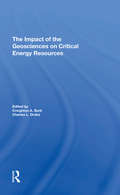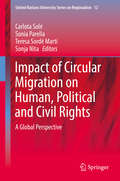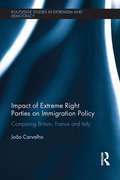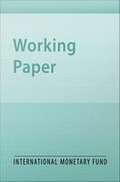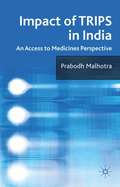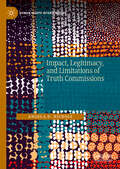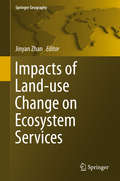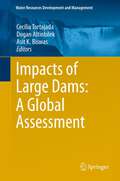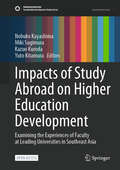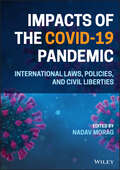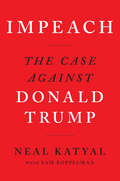- Table View
- List View
Impact Geosciences/h
by James BurkThis volume focuses on the research achievements of the earth sciences in developing the nation's energy resources and on the efforts that still must be made toward solving current and future problems. Contributors point out that efficient exploration for energy resources, evaluation and development of these resources, and effective control of asso
Impact Investing at a Crossroads: A Pathway Forward
by John Forrer Terry GrayThere is no questioning the enthusiasm that welcomed impact investing as an alternative approach to making investments: Take account of both financial returns and the social and environmental impacts. But there is no denying that the approach has fallen well short of expectations.Impact investing has shown great promise as a major transformational investment paradigm, but in practice under-performing woefully and its prospects are dimming: It comprises less than 1% of the world’s equity investments, and too many claims of success are more about marketing and reputational value than hard evidence of positive social impacts. Drawing on over a decade of hands-on experience, this book presents a unique combination of a how-to guide and a reimagining – new models, frameworks, techniques, and tools – of what impact investing could be and could accomplish. It points to a new direction for future impact investments: achieve higher financial returns, more positive social and environmental impacts, and lower risks than conventional investments. Readers will learn what actions should be taken at each stage of impact investing, and which models, analytic frameworks, and techniques to use – and how to use them – for optimal results.This book offers a step-by-step guide to how impact investing can achieve its promise of transforming global investments into a powerful positive force for change. It is an inspiring and comprehensive resource for anyone who wants to understand how impact investing works and how it can be done better, from professionals at foundations, international NGOs, consulting firms, and government agencies, to students of finance, public policy, ESG, sustainability and international development.
Impact Statement: A Family's Fight for Justice against Whitey Bulger, Stephen Flemmi, and the FBI
by Bob HalloranNo one can deny that mob boss James "Whitey" Bulger and Stephen "The Rifleman" Flemmi are two of the most brutal killers in American history—not even the two gangsters themselves. But a jury denied the Davis family closure for the slaying of Debbie Davis, Flemmi's beautiful young girlfriend, who went missing in 1981 and whose remains were found nearly twenty years later under the Neponset River Bridge in Quincy, Massachusetts.Now serving a life sentence, Stephen Flemmi testified in graphic detail how he lured Debbie to a house in South Boston where Bulger jumped out of the shadows and strangled her to death. Flemmi then extracted her teeth and buried her body by the Neponset River while Bulger watched. Bulger wanted Debbie dead, Flemmi claimed, because she knew that the two men were meeting with an FBI agent named John Connolly. That, and he might have been jealous of the time Flemmi and Debbie were spending together. Throughout his trial, Bulger stubbornly insisted that he never would have committed the dishonorable act of killing a woman. In the end, it was one stone-cold murderer's testimony against another's.In Impact Statement, veteran journalist Bob Halloran looks at the devastating impact Bulger and Flemmi have had on the Davis family, whose longstanding relationship with the two mobsters cost them a father, two sisters, and a brother. Through up-to-the-minute coverage of Bulger's criminal trial and extensive interviews with Debbie's brother Steve Davis, a one-time protégé of Flemmi's and now an outspoken advocate for the victims' families, Halloran has pieced together this unique and compelling story of a family's quest for justice.
Impact in International Affairs: The Quest for World-Leading Research (Contemporary Security Studies)
by James Gow Henry RedwoodThis book examines how and to what extent academic research in politics and international studies has had 'impact' — in doing so, it also considers what might characterise ‘world-leading’ research impact. International Relations was always meant to have impact – it was intended to make a difference in the world, when the subject was formally founded to understand and prevent war in 1919. This volume addresses the concept of ‘impact’ and offers a typology of the term — instrumental, conceptual, capacity building and procedural. The authors examine 111 impact case studies in the UK Research Excellence Framework (2014) that were classified as having achieved the highest level of evaluation, and they identify eight characteristics that mark ‘world-leading’ impact. The book concludes that process and public and media engagement are previously underestimated aspects of impact in official approaches. It further demonstrates that achieving the top levels of impact in international relations is possible, but that factors such as the nature of the subject, the approach of researchers and mean-spiritedness in the peer review process inhibited this. This book will be of much interest to students of politics and international studies, as well as educational research and policy makers, and anyone interested in, or working on, research impact.
Impact of China’s Rise on the Mekong Region
by Yos SantasombatThis volume presents a contemporary analysis of the impact of China's rise on the Mekong Region at a critical point in Southeast Asian history. As the most populated country and the second largest economy in the world, China has become an increasingly influential player in global and regional affairs in recent decades. Economic ties between China and her southern neighbors are particularly strong. Yet relations between China and the Mekong region are embedded in complex socio-cultural and political issues. China's accelerated growth, increasing economic footprint, rapid military modernization, and global search for energy, natural resources, and food security have created a wide range of new challenges for smaller countries in Southeast Asia. These new challenges both encourage and limit cooperation between China and the emerging ASEAN Economic Community (AEC). The authors pay close attention to these challenges with particular focus on the impact of Chinese investment, trade, foreign aid, and migration.
Impact of Circular Migration on Human, Political and Civil Rights
by Carlota Solé Sonia Parella Teresa Sordé Martí Sonja NitaThis volume addresses the topic of circular migration with regard to its multiple dimensions and human, political and civil rights implications from a global perspective. It combines theoretical and empirical studies and presents different case studies illustrating circular migration patterns and policies in different world regions. Circular migration processes - understood as the back-and-forth movement of people between countries and regions- form part of the changing nature of migration movements across the world at the beginning of the 21st century. Over the past decades, international, regional and internal migration flows have shown a quantitative increase and have changed in scope, context, origin and nature. Migration projects are every time more open-ended, multi-directional and flexible and often include some type of circularity. Instead of mere "push-pull-scenarios", people migrate for many different reasons, including personal, family, professional, academic or political ones. In the 21st century migration journeys and the reasons underlying them are multiple and more diverse than ever before.
Impact of EMU on Selected Non-European Union Countries
by R. Feldman K. Nashashibi R. Nord P. Allum D. Desruelle K. Enders R. Kahn H. Temprano-ArroyoA report from the International Monetary Fund.
Impact of Extreme Right Parties on Immigration Policy: Comparing Britain, France and Italy (Extremism and Democracy)
by Joao CarvalhoDrawing on a mixed research methodology with a strong qualitative character, this book traces the political impact of the British National Party in the UK, the Front National in France and the Lega Nord in Italy by exploring their contagion effects on immigration politics and policy in particular over the patterns of inter-party competition, public behaviour and policy developments. This book suggests that extreme right party impact on immigration politics and policy is an outcome of the extreme right parties’ electoral threats to established parties alongside the agency of mainstream political elites. It also highlights the decline in the intensity of extreme right parties’ contagion effects on public attitudes to immigration throughout the late 2000s or the potential overstatement of this political process in the past. Featuring detailed case studies of the UK, France and Italy as three mature multi-party democracies where the extreme right was on the rise during the past decade, this work will be of great interest to students and scholars of populism, extremism, European politics and comparative and party politics.
Impact of Macroeconomic, Political, and Institutional Factors on the Structure of Government Debt in Emerging Market Countries
by Anastasia GuscinaA report from the International Monetary Fund.
Impact of Organized Crime on Murder of Law Enforcement Personnel at the U.S.-Mexican Border
by Sara SchatzThis brief fills a gap in the studies of organized crime in Mexico (Kan 2012, Ríos 2011, Dell 2011) by documenting and mapping the post-2008 assassination of Mexican border police chiefs. It traces out a "systematic" of law-enforcement assassination in Northern Tier Mexico, showing how the selective, often sequential, hits by cartels on chiefs in border towns and along key drug-trafficking corridors has proven an effective strategy by organized crime elements to serve several goals: (1) to retaliate for federal, state and local prosecution, (2) to try and neutralize police chiefs, (3) to achieve intermittent local governance and/or to seed corrupt police chiefs at the municipal level, and, (4) to reduce local governmental capacity to obtain greater freedom for movement of goods. It is argued that the tactical advantage of organized crime elements gives them relatively easy physical access to law enforcement targets and thus is thus one prime element facilitating the use of assassination as a strategy. U. S. and Mexican legal, political and judicial institutions have not been able to adequately restrict opportunity for law-enforcement assassinations. The inability to reduce access to weapons and officials, to increase security for police personnel, to reduce corruption and punish offenders sets the stage for the assassination of local law enforcement. Yet, it is the goals of organized crime elements (to clear drug-smuggling routes and to try and gain more pliant governance at the municipal level) that ultimately motivate such killings.
Impact of TRIPS in India
by Prabodh MalhotraIn India today only 35 percent of people have access to medicines. This book examines the rise of drug prices in India, and develops a new healthcare model, which if implemented, would extend access to medicines to India's entire population. Sensitivity tests show that the proposed model is affordable, equitable and implementable
Impact, Legitimacy, and Limitations of Truth Commissions (Human Rights Interventions)
by Angela D. NicholsThis book develops a theoretical understanding of how truth commissions achieve legitimacy and contribute to peace and stability. Angela D. Nichols argues that truth commissions are most likely to impact society when they possess certain institutional characteristics—characteristics that send important political signals to the state and broader society alike. If these signals suggest greater degrees of authority, a break with the past, and transparency in both its investigations and its findings, the truth commission is more likely to impact society. In particular, Nichols examines whether or not states that adopt truth commissions with these characteristics are more likely to respect human rights and experience lower levels of violence. She concludes with an analysis of Colombia’s newly established Truth, Coexistence, and Non-Recurrence Commission.
Impacts of Land-use Change on Ecosystem Services
by Jinyan ZhanThis book aims to systematically elaborate how land-use change directly or indirectly exerts impacts on the ability of ecosystems to provide services for human society. The relationship between land use, ecosystem services and human well-being is a hot topic, and there have been some important achievements in this field, but its continuing growth means that it warrants further research. The unique viewpoint, the scientific analysis methods and the precise language of this book make it not only a valuable guide for professors conducting research, but also a reference resource to help governments make decisions on relevant policies. Prof. Jinyan Zhan is an associate professor at the School of Environment, Beijing Normal University, China.
Impacts of Large Dams: A Global Assessment
by Asit K. Biswas Cecilia Tortajada Dogan AltinbilekOne of the most controversial issues of the water sector in recent years has been the impacts of large dams. Proponents have claimed that such structures are essential to meet the increasing water demands of the world and that their overall societal benefits far outweight the costs. In contrast, the opponents claim that social and environmental costs of large dams far exceed their benefits, and that the era of construction of large dams is over. A major reason as to why there is no consensus on the overall benefits of large dams is because objective, authoritative and comprehensive evaluations of their impacts, especially ten or more years after their construction, are conspicuous by their absence. This book debates impartially, comprehensively and objectively, the positive and negative impacts of large dams based on facts, figures and authoritative analyses. These in-depth case studies are expected to promote a healthy and balanced debate on the needs, impacts and relevance of large dams, with case studies from Africa, Asia, Australia, Europe and Latin America.
Impacts of Racism on White Americans In the Age of Trump
by Benjamin P. Bowser Duke W. AustinIn this third iteration of the classic work The Impacts of Racism on White Americans (1981, 1996), a new generation of scholars make the case that racism often negatively affects Whites themselves, especially during the Trump era. In 1981, Impacts introduced an alternative understanding of racism, arguing that it went beyond white-black and/or inter-race relations. Instead, the book proposed that the problem of race in the U.S. is fundamentally one of white identity and culture and that racism has substantial negative effects on White Americans. This volume advances these propositions through three key areas: (1) Trump-era cultural and institutional racism, bolstered by the use of historical notions of racial hierarchy; (2) institutional and interpersonal racism, which in turn drive individual racist behaviors; and finally, (3) racism’s interactional sequences and how they impact anti-racism efforts. As each chapter author explores an iteration of these racisms, they also explore how racist attitudes produce disadvantage among White Americans.
Impacts of Study Abroad on Higher Education Development: Examining the Experiences of Faculty at Leading Universities in Southeast Asia (Sustainable Development Goals Series)
by Yuto Kitamura Kazuo Kuroda Nobuko Kayashima Miki SugimuraThis open-access book is an exceptional contribution to the burgeoning fields of higher education development and higher education internationalization as it empirically examines the impact of the study abroad experiences of faculty members on individual and institutional development. The research and its outcomes presented here utilize results from a large-scale survey and interviews of faculty at ten leading universities in Malaysia, Indonesia, Vietnam, and Cambodia. The analyses show that the study abroad experiences of faculty members impact not only improvements in research quality and development of educational programs but also serve as the foundation for international activities at the university, crucially important in today’s higher education landscape. On the other hand, the research reveals the rapid development of higher education at the local and regional levels including the development of graduate programs for faculty training in the home country leading to increasing rates of study abroad within Southeast Asia. Through the analyses presented, this book offers a new understanding of higher education development and internationalization in Southeast Asia by examining the impact of study abroad on the academic profession, higher education institutions and the higher education sector.
Impacts of the Covid-19 Pandemic: International Laws, Policies, and Civil Liberties
by Nadav MoragIMPACTS OF THE COVID-19 PANDEMIC Enables Readers to Understand the Impact of International Legislative and Policy Responses to the COVID-19 Pandemic The wide array of legal and policy responses to the COVID-19 pandemic have significant implications regarding the functioning of countries and their respective societies. This book addresses the impact of international legislative and policy responses to the COVID-19 pandemic in a range of countries. To aid the reader in understanding country-specific developments, each chapter focuses on a specific country and addresses the legal frameworks and policy approaches used to support measures to prevent transmission and otherwise reduce the impact of the virus on society and the economy. Sample topics discussed in the work include: The effect certain policies may have on civil liberties, such as due process, and the right to privacy in specific countries The provision of public goods in the face of the pandemic Policymakers in public health agencies and other branches of government, along with academics studying global pandemic response, homeland security, and emergency management will be able to use this book as a comprehensive resource to understand the current state of COVID-19 policies around the world and the potential future effects of these policies.
Impacts on U.S. Energy Expenditures and Greenhouse-Gas Emissions of Increasing Renewable-Energy Use
by Robert J. Lempert Michael Toman James GriffinHow could producing 25 percent of U.S. electricity and motor-vehicle transportation fuels from renewables by the year 2025 affect U.S. consumer energy expenditures and CO2 emissions? This report finds that reaching 25 percent renewables with limited impact on expenditures requires significant progress in renewable-energy technologies and biomass production. Without substantial innovation in these areas, expenditures could increase considerably.
Impaired Judgment
by David ComptonBook Description The new First Family plans to restore honor to the White House, and First Lady Paula Candler, to show she's just another working mom, decides to retain her position as a Virginia federal judge. The president, a devoted husband and father, supports his wife completely, and they share everything--at least until she is assigned to hear the case against reputed mobster Tony Remalli, who is accused of murdering another female judge. Representing Remalli is legendary Mob attorney Don Ross, whose law-skirting investigator hits pay dirt in his effort to dig up dirt on the supposedly pristine Paula Candler. When Ross uses the evidence to blackmail the judge, Candler is faced with the moral dilemma of letting bullies rule her courtroom or risking the safety of her family and the future of her husband's presidency. Compton fashions an exciting legal thriller that uses its high-concept premise to good advantage.
Impairment and Disability: Law and Ethics at the Beginning and End of Life (Biomedical Law and Ethics Library)
by Sheila McLean Laura WilliamsonThis book explores legislation intended to protect the interests of people with disabilities or impairments. Considering a broad range of ethical and legal concerns which arise in issues of life, death and disability, it covers the social and legal responses to the equality rights of disabled people, focusing on those responses to: the right to life the end of life assisted suicide. This work engages with contemporary debates, examines case studies and explores the problems surrounding many legal concepts within the context of disability and impairment. The authors argue that it is crucial to distinguish between unjust discrimination and differential treatment and unify the disagreements surrounding the issues by highlighting ethical ideals that should be shared by all stakeholders in life and death decisions that impact on people with disabilities. Topical and contemporary, this book is a perfect supplementary text for students of all levels and researchers working in the areas of law, applied ethics and disability theory.
Impeach the President: The Case Against Bush and Cheney
by Dennis Loo Peter PhillipsArticles witten by many authors citing the reasons why President George Bush shuld be impeaced.
Impeach the President: The Case Against Bush and Cheney
by Howard Zinn Dennis Loo Peter PhillipsThis brilliantly argued and wonderfully written collection by twenty-two of the best political analysts in the US analyzes the extraordinary and unprecedented threat the White House and its allies present to civil liberties, civil rights, the Constitution, international law, and the future of the planet. Impeach the President unearths the stories behind election fraud in 2000 and 2004, the overt lies used to justify pre-emptive war on Iraq, the extensive, ongoing commission of war crimes and torture, the tragic failures in the lead-up to and aftermath of Hurricane Katrina, and lesser-known but equally alarming offences of propaganda and disinformation, illegal spying, environmental destruction, and the violation of the separation of church and state. Loo and Phillips chillingly reveal the full threat behind the radical right-wing force that has taken over the world's most powerful office.
Impeach: The Case Against Donald Trump
by Neal Katyal Sam KoppelmanAn acclaimed Supreme Court lawyer and former Acting Solicitor General argues why impeachment is the only remedy for the dangers posed by President Trump.No one is above the law. This belief is as American as freedom of speech and turkey on Thanksgiving—held sacred by Democrats and Republicans alike. But as the celebrated Supreme Court Lawyer and former acting solicitor general Neal Katyal argues in Impeach, if President Trump is not held accountable for repeatedly asking foreign powers to interfere in the 2020 presidential election, this could well mark the end of our democracy. After all, as President George Washington said in his Farewell Address: “Foreign influence is one of the most baneful foes of our republican government.”Impeachment should always be our last report, explains Katyal, an “extreme centrist,” but our founders, our principles, and our Constitution leaves us with no choice but to impeach President Trump—before it’s too late.An instant New York Times bestseller.
Impeached: The Trial of President Andrew Johnson and the Fight for Lincoln's Legacy
by David O. StewartAfter the Civil War, the nation came close to tearing itself apart, again, during the impeachment struggle between Congress and President Andrew Johnson in the spring of 1868.
Impeachment (Cornerstones of Freedom)
by Andrew SantellaSurveys the history of impeachment in the United States, discussing the basic rules and procedures and notable officials who have been impeached.
